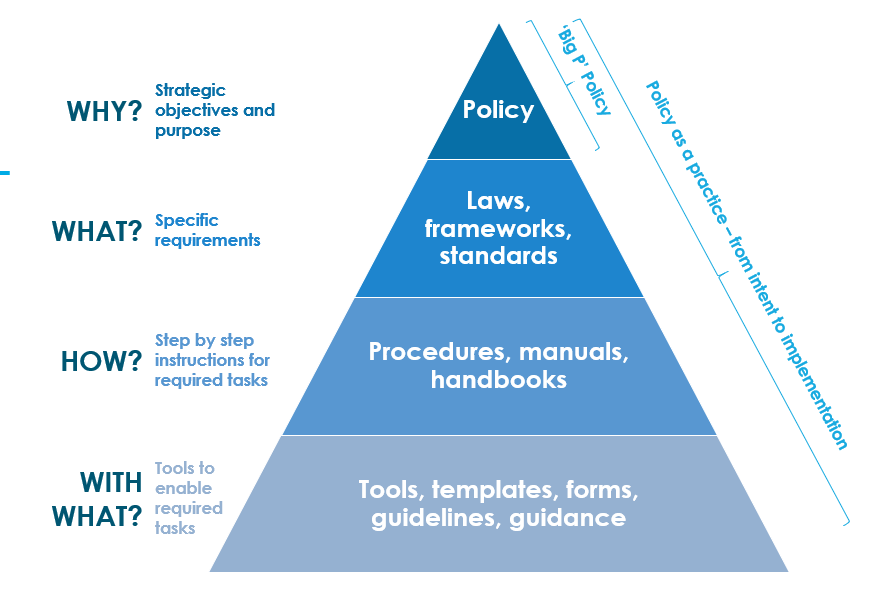"We need a policy on this" Public service proverb
'We need a policy on this' is a familiar phrase to any public servant, but what does it really mean? What is a 'Policy with a capital P', as opposed to "policy" as a concept and practice?
As a Policy Lab, we've been thinking a lot about this. After all, you can't set out to make better public policy unless you can say what exactly you're trying to improve.
So, here's how we see it. Note, this isn't a settled model yet - we're interested to hear what you think.

Let's start with some ground rules
A big P Policy sets the ultimate objective and provides the 'why', but it's difficult to create good Policy without some guidelines in place. So, we need to agree that Policy should establish:
- Policy intent - outlining what is trying to be achieved through a clear strategic objective or set of objectives.
- Purpose of the Policy - outlining why the strategic objective is important. For example, who are the users and subjects of the Policy? What is the user or community need that the Policy is intended to address or the problem that the Policy is intended to solve? How was this established? How will the Policy meet user or community needs or otherwise benefit the community?
- Owner of the Policy - set out roles and responsibilities and outline expectations for all staff.
- Supporting documents - should reference the Policy so that their purpose for existing is clear.
Supporting documents provide the 'what' and the 'how'
'What?'
The Policy should be supported by prescriptive requirements â these set out what must be done to achieve the Policy intent. In government, these rules could be set out in laws or documents such as frameworks or standards.
Laws can be used to establish key requirements and enable regulatory enforcement, but this approach isn't always necessary.
Frameworks may support or expand on the Policy (or the legal requirements) by outlining the elements of the system that underpin the Policy. The framework could set out and illustrate the connections between business processes, inputs and outputs, key stakeholders and relationships or logical decision points. See, for example, the Human Services Outcomes Framework, which sets out the elements of how to measure outcomes to support the NSW Premier's and State Priorities.
Standards may set technical and prescriptive rules that dictate what should happen by establishing minimum requirements. Standards can help ensure consistency both within an agency or government and with other jurisdictions. For example, the NSW Digital Design System, which is intended to help creators make consistent and accessible NSW Government digital products, includes a Design Standards that prescribes minimum design requirements.
'How?'
We know why we're doing it and we know what we must do. Procedures and manuals help to achieve the Policy intent by laying out the specific tasks within business systems that must be performed to comply with relevant standards and frameworks.
With what? Tools, Tips and Tricks
Finally, we may create ways to make it easier to do the tasks described in the procedures and manuals, such as reusable components, tools, forms, templates, and guidance. These should be referenced in procedures and manuals, with information about how and when they should be used.
Mix and match
In the digital space, we've noticed that NSW has taken a variety of approaches.
Specifically, we've found that the four classifications may be combined in various ways.
For example, the "big P Policy"is not always contained in a document with 'Policy' on the cover page. In government, this top layer is often contained in a document called a "strategy', 'framework' or 'plan', but that meets the characteristics of the "big P Policy" setting out intent, objectives, and purpose, as well as establishing specific requirements. On the other hand, some agencies may combine all four tiers into a single monster-sized document that combines the top-level strategic objectives, standards, procedures and tools.
What does this all mean?
We think it means you should identify a clear intent and purpose before you do anything else. That intent should be based on a good understanding of what the users of the policy need and should set out how the policy will benefit the community. The "why" should inform all the components that sit underneath.
So, the next time someone tells you "we need a 'policy', start by asking 'why?'.
Attributions: This blog post draws on the insights of Carol Feuerriegel as set out in her article, Governance Documents - creating a 'Common Language' for Corporate Governance.